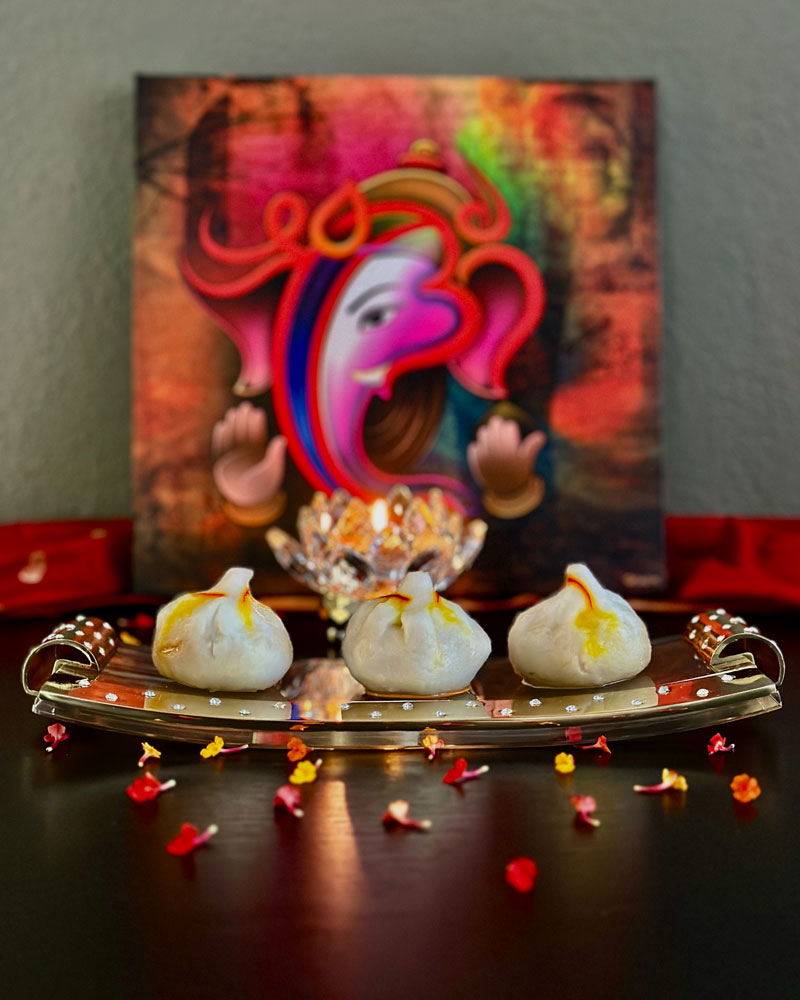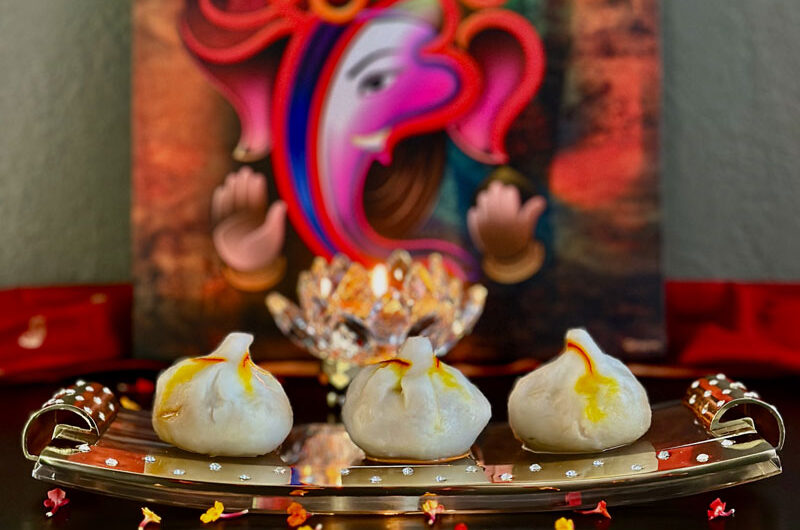The Indian holiday season begins with the 10 days of Ganesh Utsav (festival) followed by the 10 days of Navratri & Dussehra before it ends with the big bang festival of lights, Diwali. To kick off the first Indian holiday, we have our dear Ganpati Bappa’s favorite – steamed modak!

Everyone simply loves these traditional sweet treats from the western Indian state of Maharashtra, called Modak. They are steamed rice-flour dumplings stuffed with a sweet filling made with grated coconut, jaggery (palm sugar) or sugar and some spices. The dumpling dough made out of rice flour is not sweet but in fact is slightly salty and compliments very well the saccharine filling inside.
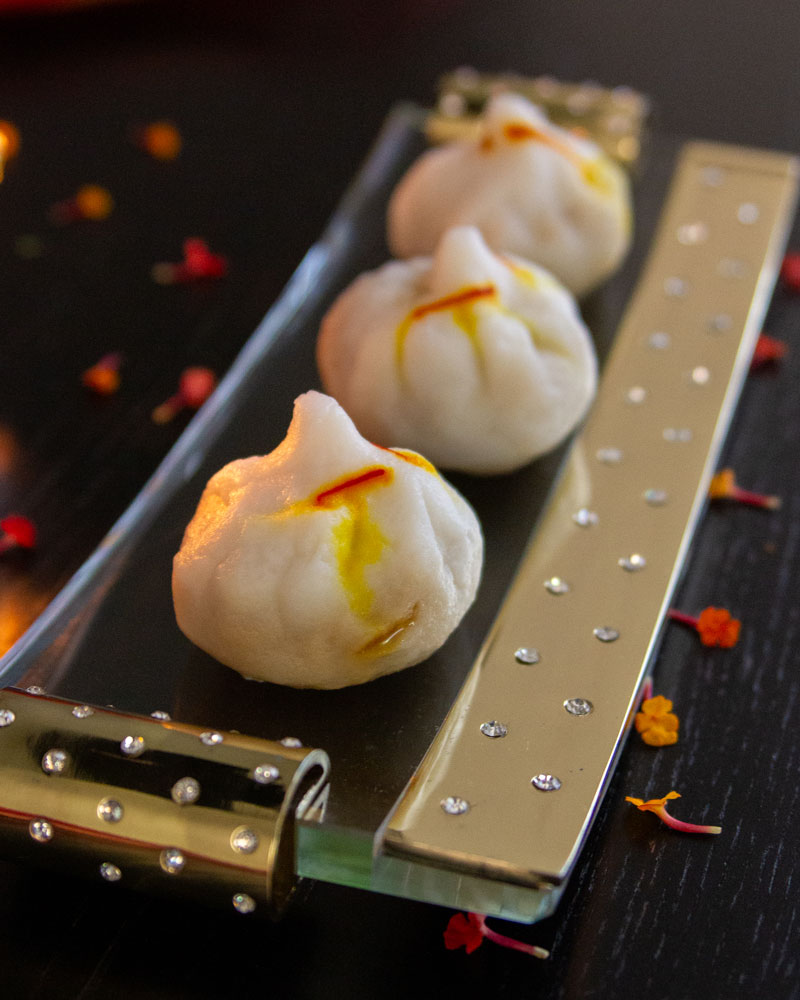
Just like many people celebrating the festival, I am excited for Ganesha’s arrival this year and even more excited to share my family’s recipe for the traditional sweet treat. Just as my parents get a new Ganesha idol for the festivities every year, I love to change things up and use a beautiful GitaDini Ganesh canvas wall art instead of the same old idol. I believe it truly adds to the festive vibe!
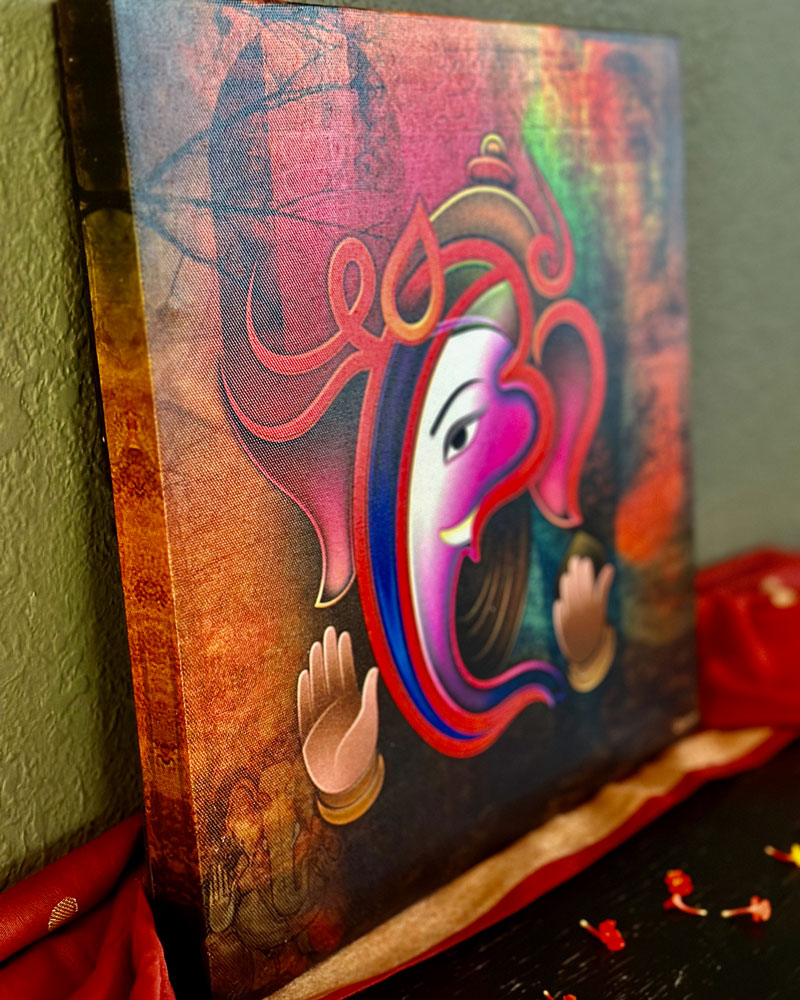
GitaDini Crystal Lotus Votive Holder makes for a perfect accessory for holding the tealight at prayers during the holiday especially because Ganesha is associated with the lotus flower and is typically shown sitting on it or often holding one in His hand.
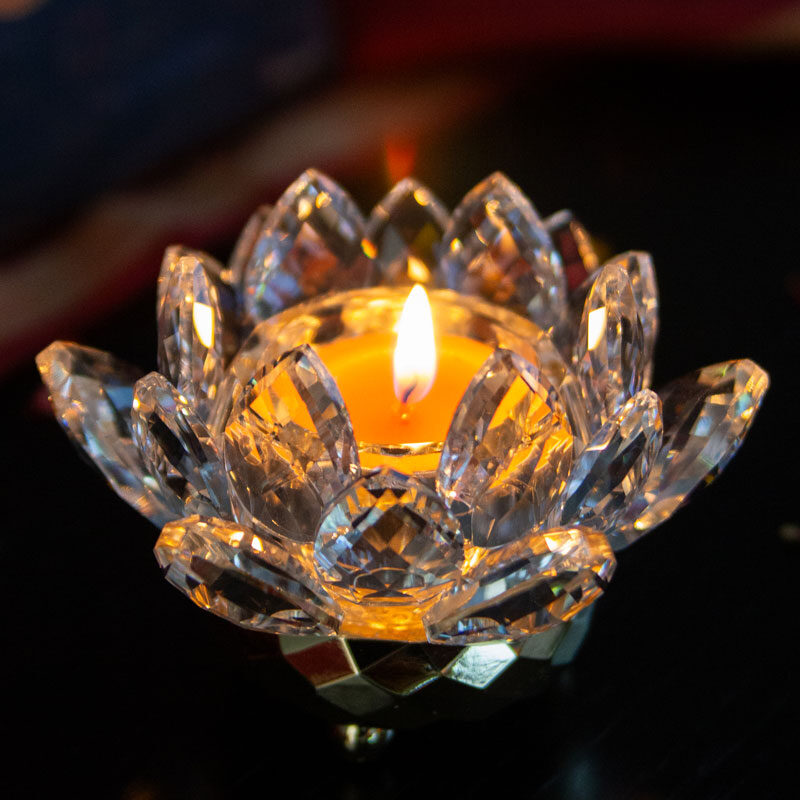
I’m thrilled to share my family’s recipe for making Ganesha’s favorite treats. Of course, just like with all my recipes, I’m adding my own little twist. I prepare the filling slightly differently, and I also strive to make the dumplings from scratch, without using a mold. So, while they may appear rustic and not perfectly shaped, they are still authentic in taste. This recipe yields about a dozen dumplings, but you can easily adjust it to make smaller or larger batches.

When offering them in prayer, I like to arrange 3 or 4 of the dumplings on the beautiful and elegant GitaDini Crystal Tray with metallic and rhinestones.
Steamed Modak – a traditional sweet treat for Ganesh festival
12
dumplings1
hour30
minutes30
minutesModak are traditional sweet treats from the western Indian state of Maharashtra. They are steamed rice-flour dumplings stuffed with a sweet filling made with grated coconut, jaggery (palm sugar) or sugar and some spices.
Ingredients
- The Filling
1½ cups grated fresh coconut (thawed if using frozen)
¾ cup powdered jaggery (i.e. palm sugar) or coconut sugar
¼ cup light cream or half ‘n’ half (or even whole milk works!)
1 tbsp white poppy seeds (khus khus), optional
1-2 tbsp Everest Milk Masala (alternatively you can coarsely grind together- 4-5 green cardamom pod seeds, 1-2 saffron strands, couple pinches of ground nutmeg, 4-5 pistachios, 4-5 cashews and 4-5 almonds)
- The Dough
1 cup of water + more for kneading
1 tsp ghee or neutral cooking oil (like avocado) + more for kneading + greasing the steamer trays + serving
½ tsp salt
1 cup of rice flour
- Special Equipment
Traditional Indian Modak / Idli Steamer or a Chinese bamboo steamer
Directions
- Making the Filling
- In a small saucepan, combine all the ingredients and place it on medium low heat.
- Cook covered for 15-20 mins till the jaggery is completely dissolved, milk is absorbed and the coconut is cooked through.
- Stir occasionally to make sure it doesn’t stick to the bottom of the pan.
- Set aside until you are ready to use it. You can make this filling a couple of days in advance and refrigerate it until ready to be used.
- Making the Dough
- To make the dough, bring the water along with ghee or oil and salt to a gentle boil over medium heat.
- Once you start seeing bubbles in the water, add the rice flour to it and mix roughly till most of the moisture is absorbed.
- Cook covered for 2-3 minutes on low heat. It is okay if the dough looks too dry or crumbly at this point.
- Take the pot off the heat. Let it rest, covered, for about 15 minutes, allowing the dough to continue cooking in the residual heat while at the same time, letting it cool down enough to handle.
- Spread ghee/oil on the palms, sprinkle very little water if needed and knead the mixture into a soft, crack-free dough ball. Let it rest, covered with a damp kitchen towel, for 15 minutes.
- Shaping the Dumplings
- Fill a small bowl with water to wet your hands for shaping the dumplings.
- Divide the dough into 12 equal parts and roll each into a ball. Keep the rest of the balls covered with the damp kitchen towel while you work with one.
- Wet your fingers and take one ball of dough. Hold the ball in between your hands with your fingers and then make a dent in the middle with both your thumbs.
- Using your fingers and thumbs, gently press the dough, putting pressure in the center and then moving outwards, in a circular motion and spreading it into a thin, round disc, about 4 inches in diameter.
- Place about a tablespoon of the prepared filling in the center of the prepared dough disc and pinch the sides making 12-13 pleats all around. Here’s a quick video that might make it easy to understand this step.
- Bring the pleats together in the center, to form a dome-like shape and gently press them together to seal the dumpling. Pinch the top and shape it into a peak and also gently pinch along the pleats to reshape them if needed.
- Set the prepared dumpling aside, covered with a damp kitchen towel.
- Similarly make the rest of the dumplings.
- Steaming the Dumplings
- Grease the steamer trays with ghee. If using a bamboo steamer, use parchment paper rounds.
- Place the prepared dumplings on the tray or the parchment paper. You can place a saffron strand on each dumpling for flavor and presentation. It will impart a golden color around it with the steam.
- Place the tray in a steamer or a pot with simmering water. You can also place the trays in an Instant Pot or a pressure cooker.
- Cover with a lid that has a venting hole and steam for 10-12 minutes. If using an Instant Pot, turn the sealing valve to venting position. If using a pressure cooker, do not use the whistle.
- Once the steaming is complete, let the dumplings rest in the covered pot for 5 minutes, after which you can take them out and transfer to a serving platter.
- Drizzle ghee on top and serve warm.

This lovely recipe has been created by Vasanti, creator of the Indian food blog Signature Concoctions. On her blog she shares a modern take on Indian cuisine that is cooked at home for family and friends, using new techniques and fresh ingredients, while staying true to its authenticity.
Find more delicious recipes in her new cook book!
You can also follow Vasanti on
